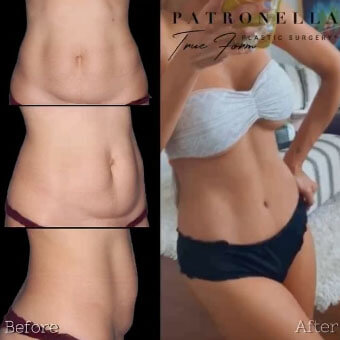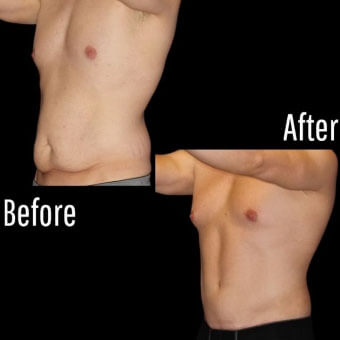Silicone vs. Saline Implants: Why Silicone Rules for Breast Augmentation
Posted December 29, 2014 in Breast Augmentation
By Dr. Chris Patronella and Sherri Roberts
 |
| This patient, a 36-year-old mother of three, opted for breast augmentation with silicone implants to give her breasts a shapelier appearance. Like many women, she experienced breast volume loss after pregnancy, going down to a B cup. Using a 295 cc silicone implant for the right breast and a 275 cc silicone implant for the left, Dr. Patronella restored the natural-looking feminine contours she desired. |
When it comes to making the choice between silicone or saline breast implants, silicone implants are the overwhelming favorite for my breast augmentation patients, with 75% percent of them choosing them over saline. And statistics indicate this preference is shared by women nationwide: 72% of the 330,631 individuals who underwent breast augmentation in 2012 opted for silicone implants compared to 28% who chose saline, according to statistics released by the American Society for Aesthetic Plastic Surgery.
The silicone breast implant’s primary advantages over its saline counterpart is twofold: it has a soft feel similar to that of natural breast tissue, and—because of its cohesiveness—it’s less likely to display the appearance of rippling. This means that silicone implants tend to hold their form better than saline implants, in which the water drops to the bottom and also gives them a harder feel somewhat like a water balloon. The complete non-cohesiveness of saline water makes the visibility of ripples on the breast more likely, particularly in patients of a thin build who have little breast tissue to disguise the implant and its edges. In contrast, the edges of silicone implants tend to be less palpable, so they are more likely to look and feel more naturally blended with the body.
The latest generation of silicone implants are the result of an ongoing quest to develop an implant that’s perfectly soft yet close to solid—something that won’t ripple, yet is soft and maintains its shape. Since making its debut more than 50 years ago in 1962 when the first breast augmentation surgery with silicone implants was performed in Houston, this popular device has undergone an evolution from its pioneering prototype. There’s been a transition over the decades from a very liquid silicone gel that could easily bleed through the implant shell, creating a greater likelihood for inflammation to develop and subsequently scar tissue and hardening. In newer generations of implants, the shell has become more technologically stable, preventing the tendency of gel to weep through the shell, which, in turn, lessens the likelihood of inflammation and the development of scar tissue and hardening. In addition, because the gel has gradually become more cohesive and stable in its form, the risk of the implant rupturing is decreased and the longevity of results is improved.
Because the silicone implant is filled with a cohesive gel, by definition it has a more stable form, which translates to better breast projection, less sprawl to the side, and a more ideal aesthetic breast shape. With these advances in technology, I am able to help my breast augmentations patients achieve the result that the majority of them ultimately desire to attain through surgery: a fuller, shapelier breast contour that looks and feels as authentic as the naturally created breast.








